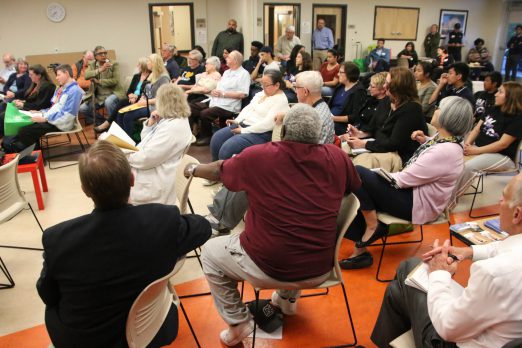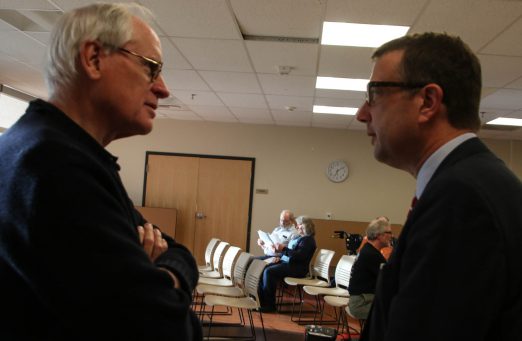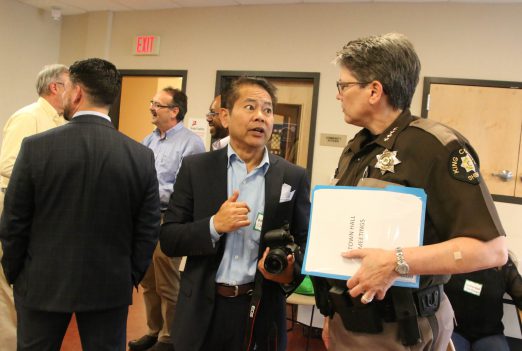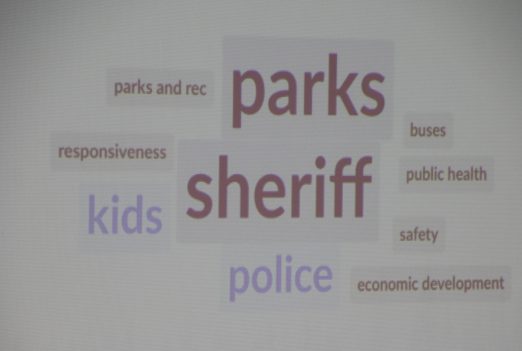VIDEO: Conversation with the county @ North Highline Community Service Area Town Hall
By Tracy Record
White Center Now editor
It’s the county’s chance to have a conversation with you, explained County Council Chair (and District 8 rep) Joe McDermott, emceeing last night’s Community Service Area Town Hall for North Highline/White Center.
A parade of high-ranking county officials followed, as the event at Seola Gardens unfolded. Something new this year: The county is launching its new initiative to serve local areas in a different way. (Added: Full video of the event:)
Specifically:
“How do we act as a city?” is what deputy executive Fred Jarrett said about the launching of the Department of Local Services. That’s especially relevant to White Center, an urban but unannexed/unincorporated area.
Harold Taniguchi – director of transportation, who is working on the Department of Local Services initiative – said it will be up and running by the start of next year. He said the department should make things run more efficiently and effectively, with a focus on customer service. And, “we hope to be out in your communities in an organized way …” with more listening. “You get the feeling that sometimes we are listening – we hope to change that up.”
As part of the Local Services launch, some departments will be no more – Transportation among them, he noted. (Transit is splitting out and becoming its own department.) But transportation projects are in the works for the area all the same, Taniguchi promised – the 8th/108th mini-roundabout is on the way, and one at 8th/102nd will follow, he said, also mentioning drainage work on South 96th
He ran the crowd – estimated at 40+ – through an on-the-spot online poll via Slido.com, with such questions as, how should the Department of Local Services communicate with you?
Next, Sheriff Mitzi Johanknecht cited a “five-month run of re-energizing the department,” so far. She says she’s working on a strategic plan, and community involvement is coming up. “It’s been an honor to serve so far.”
Deborah Jacobs, director of the Office of Police Oversight, followed the sheriff. Part of her office’s charge is to “bring the civilian voice.” She added that her department looks at the trees as well as the forest, and offers policy feedback to the sheriff. They’re also supposed to take on independent investigations, but that’s still subject to “collective bargaining with the unions.”
Kevin Brown, director of Natural Resources and Parks, mentioned that Movies in the Park will be at Seola Gardens at August 4th. Lots going on at Steve Cox Memorial Park, he added, including a kids-cooking program and more. He touted the June 6th Peace in the Hood jobs event (featured here on WCN). Also at Cox Park, the new $3 million field project for multiple sports is in the works – “one of the first publicly available synthetic field in this area.” The work means Jubilee Days needs a new carnival spot this year and that has not yet been worked out, Brown said.
Jake Tracy from the Department of Permitting and Environmental Review spoke next – marijuana is his main job and there’s a study happening right now regarding unincorporated areas, including a public-comment period. It’s related to concerns about clustering of marijuana businesses. It’s studying five areas including whether zoning needs to change to open up new areas “to meet our allocation from the state” and how unincorporated areas are being affected by the way things are. They’re studying complaint and crime data. The survey is taking comments through the end of June.
Mark Ellerbrook from the Department of Community and Human Services, who manages the county health and homeless services, followed. He said his department also is working on the opioid crisis, including helping people who want help get it immediately. He ran through a long list of other services his department provides, including administering the Veterans, Seniors, & Human Services Levy.
After short speeches, poll results from Harold – 15 participants, Sheriff and Parks were the single words with the most positive effect on the community.
Social media – “local blogs” were included – won for communication choice, with e-mail right behind. Safety and homelessness were the most-cited community challenges. And there was a long list of suggestions for what the county could do to help the community.
Then – open microphone for questions. Liz Giba, president of the North Highline Unincorporated Area Council, was first. She had sent a letter to various officials about the Burien murders of two young women and said she was troubled to not receive a single reply. She is concerned about the concentration of poverty in White Center and what’s being done to make it a more economically healthy community – more healthy overall. “What are you doing? What plan is there? Is there any answer?”
McDermott replied, “Is there enough of an answer? Probably not.” But some steps are being taken, he said, citing for example the Best Starts for Kids levy and its investment in youth. He also cited the expansion of the Veterans Levy. Giba followed up with her long-held concerns about another low-income development in the works at 8th/108th – more “concentration of poverty” – “when you continue to shove more people who need help into a small space, (a few) square miles, there’s going to be trouble.” She asked the county to reconsider what’s happening with the 8th/108th site. She said that it could be a home for various groups/agencies (which is part of what’s proposed for the possible future project). McDermott added that more housing needs to be built and that might result in “more than some people would like to see in some communities.”
The sheriff said that the investigation of the murders continues and she is traveling out of town soon to visit with one victim’s family. She acknowledged that the department has very little resources devoted to gangs but they’re trying to work more on that “across boundaries.” Gangs are a culture. “We’re close to solving” the murders, “but so much goes into this, and much of it, you can’t see.”
Asked by Carol from Myers Way about homelessness, Councilmember McDermott said it’s still a work in progress. He was also asked about minimum wage and whether the county might follow Seattle’s lead. He said it would make more sense if the state looked at its law.
Ellerbrook then took on the affordable-housing issue – saying 80,000 to 90,000 units is the current estimated gap countywide. More is needed in every community, he said. Over the course of a year, 30,000 people experience homelessness, he said. 24,000 people came in for services and many didn’t need them again. “Employment is critical,” he agreed. If someone becomes ill, for example, they might lose their (expensive) apartment and possibly never be able to get into one again. He also brought up common concerns that unsheltered people have about shelters, and how it might mean more healthy people, more people connected to services, if they can improve the shelter system. The county is working on its budgeting for homeless services and both navigation and services for vehicle residents are two areas they’re working on.
Barbara Dobkin of NHUAC brought up a petition the group had circulated at last year’s Jubilee Days, talking about the area’s low-opportunity status. They want the group to study issues such as WC’s housing situation.
Community advocate Gill Loring voiced concern that the county still is not reaching out to the diverse groups that make up the area’s population – pointing out that almost everyone at the meeting was white, until a youth group arrived. “I don’t hear it from the county, I don’t hear it from Dow, I don’t hear it from the council,” he said. ”… let’s all come together, let’s be one community … why can’t the county do something about that?”
McDermott responded by explaining the race-and-social-justice lens through which the county does its work, while acknowledging that outreach efforts need to be more successful. He also mentioned that the group was largely older, too.
It was then explained that the youth who had arrived are members of an internship program, White Center to White House, and one of them spoke next. She expressed concerns about the new youth detention center on Capitol Hill. McDermott said he believes the new center is necessary “until we reach our aspirational goal of zero youth detention.” The two had some back and forth. She wondered why community-based programs couldn’t be used instead. He said we are still at a point where some youth need to be separated from the community “for their own protection and that of the community.”
Jarrett also took the microphone to say that the county also is working on a plan to see how they will get to zero youth detention. He spoke about the subpar conditions at the building that the new center will replace. He also said part of it has been “reprogrammed” to be a nonsecure area where kids who need a safe place to go during a family crisis, for example, can be helped. And he went further, saying that work to get to a world where youth detention isn’t needed will take years.
The next person with a question/concern, also a youth, said that White Center schools (such as Evergreen High School) need more rigorous courses, more teachers of colors, more security, more technology access, and more building improvements. He presented McDermott with a letter, and he in turn promised to share it with state legislators and Highline school board members. He said that through the Sound Transit taxing district, King County will be getting a small amount of money to invest in education for the next 20 years.
Then a statement from community member Bob Price: The cause of homelessness needs to be addressed, not just the symptoms.
After him, Rudy Garza from the Coalition of Drug-Free Youth, who said that marijuana access is an increasing problem for youth. They see the proliferation of stores, they see the prevalent use, and figure it’s OK. “Where does it stop?” McDermott noted that legalization resulted from a statewide vote of the people.
Tracy said his work includes – as he had said earlier – looking at ways to avoid clusters of stores and to mitigate marijuana’s effects on communities. “Educating youth on why they shouldn’t use marijuana” is very important, he said. A discussion of shops’ locations ensued as well as where the tax money from marijuana goes. “We will have a report in the very near future,” Jarrett said. He added that a larger concern for people should be what percentage of their sales tax comes back to the county. Putting together the report is very complex, others added.
Another speaker reiterated concerns about the concentration of marijuana shops in Top Hat, and contended that they are keeping other businesses from coming to the area. “(It’s) hurting the community in so many ways,” she said.
Next concern voiced: Overgrown right of way. Taniguchi asked that specific locations be provided to reps at the meeting so they can check it out and potentially take action.
Then with one final question about the county partnering with schools – McDermott reiterated that he will share the youth concern with the school district, Jarrett advised focusing on the Legislature – the event wrapped up. The questioner countered that he doesn’t believe funding would be required for the county to partner with the district.
You can follow any responses to this entry through the RSS 2.0 feed. Both comments and pings are currently closed.





June 1st, 2018 at 10:07 am
Thank you for the detailed coverage on this, and for the video coverage! I miss so many community meetings in White Center because of my schedule, and always appreciate a thorough and video-based recap — it’s the next best thing to a live stream where more of us can participate!